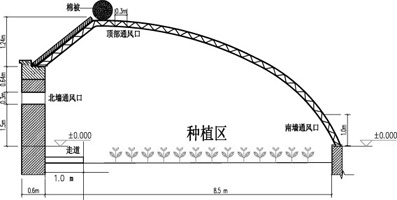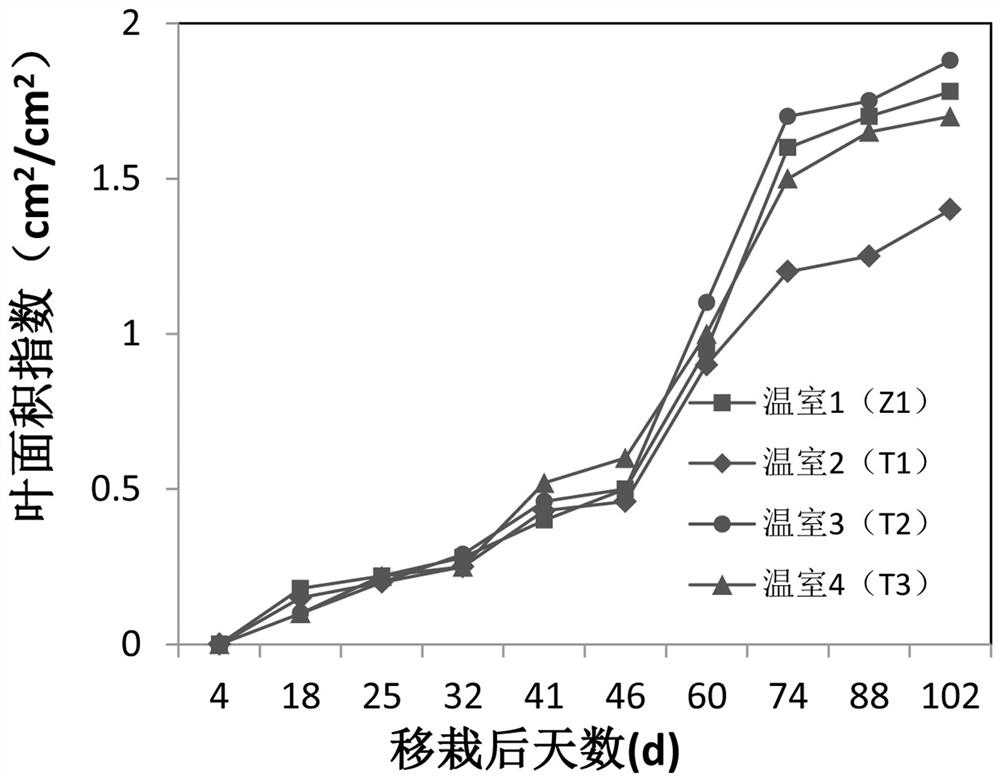The method of increasing tomato yield in spring solar greenhouse by regulating ventilation mode
A solar greenhouse and tomato technology, applied in fruit tree cultivation, etc., can solve problems such as the lack of accurate and effective environmental regulation theory, and achieve the effects of improving water use efficiency, reducing fruit cracking, and meeting growth needs
- Summary
- Abstract
- Description
- Claims
- Application Information
AI Technical Summary
Problems solved by technology
Method used
Image
Examples
Embodiment 1
[0023] Example 1: The test personnel carried out this test in the solar greenhouse of the Xinxiang Ecological Experiment Base from March to July 2018. This area belongs to the warm temperate continental monsoon climate zone, and the average annual rainfall and evaporation are respectively 550 and 1910mm. The average annual temperature is 14.1°C. The solar greenhouse structure selected in this embodiment is as follows: figure 1 As shown, the greenhouse covers an area of 510m 2 (Length 60m, width 8.5m), digging down 0.5m, facing east-west, facing south, covered with 0.2mm thick non-drip polyethylene film; there are 3 vents in the solar greenhouse, which are located on the top of the greenhouse (60m×30cm ), the south side (60m×1.5m) and the north side (2cm×2cm, N=19), the soil in the test area is loamy soil, and the average bulk density, field water holding capacity and withering coefficient of 0-60cm are 1.49g / cm 3 、0.32cm 3 / cm 3 and 0.09cm 3 / cm 3 .
[0024] The tomat...
Embodiment 2
[0029] Embodiment 2: The conditions of the solar greenhouse, the tomato variety, and the planting method in this embodiment are the same as those in Embodiment 1, and the similarities will not be described in detail. The difference is: the combined ventilation method adopted in the growth stage of tomato growth in this embodiment For Z2, specifically:
[0030] Seedling stage (March 10-April 3): After the tomato seedlings are transplanted, pour 20mm seedling water to slow down the seedlings. The whole seedling stage adopts a south-north ventilation mode and closes the top window vents; at this stage, the greenhouse Cumulative evaporation E through 20cm standard evaporating dish p Determine the amount of irrigation water, when the accumulated evaporation E pIrrigate when the value reaches 20±2mm, and the irrigation volume is 0.9E p .
[0031] Flowering and fruit-setting period (April 3-May 15): The daily average cumulative temperature is ≤875°C, adopt the top-north ventilatio...
Embodiment 3
[0033] Embodiment 3: The conditions of the solar greenhouse, the tomato variety, and the planting method of this embodiment are the same as those of Embodiment 1, and the details of the same content will not be repeated. The difference is: the combined ventilation method adopted in the growth stage of tomato growth in this embodiment For Z3, specifically:
[0034] Seedling stage (March 10-April 2): After the tomato seedlings are transplanted, pour 20mm seedling water to slow down the seedlings. The whole seedling stage adopts a south-north ventilation mode and closes the top window vents. Irrigate tomato seedlings when the average soil moisture content of 60cm is less than or equal to 65% of the field water holding capacity;
[0035] Flowering and fruit-setting period (April 2-May 12): The daily average cumulative temperature is ≤900°C, adopt the top-north ventilation mode, and close the south vent; the daily average cumulative temperature is >900°C, adopt the south-north-to...
PUM
 Login to View More
Login to View More Abstract
Description
Claims
Application Information
 Login to View More
Login to View More - R&D
- Intellectual Property
- Life Sciences
- Materials
- Tech Scout
- Unparalleled Data Quality
- Higher Quality Content
- 60% Fewer Hallucinations
Browse by: Latest US Patents, China's latest patents, Technical Efficacy Thesaurus, Application Domain, Technology Topic, Popular Technical Reports.
© 2025 PatSnap. All rights reserved.Legal|Privacy policy|Modern Slavery Act Transparency Statement|Sitemap|About US| Contact US: help@patsnap.com



